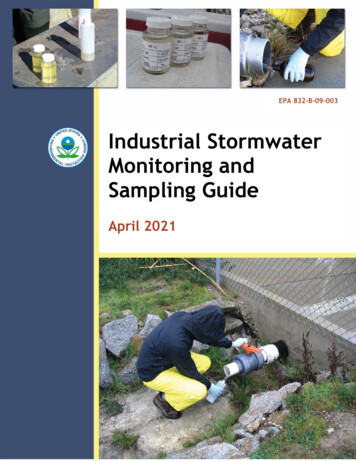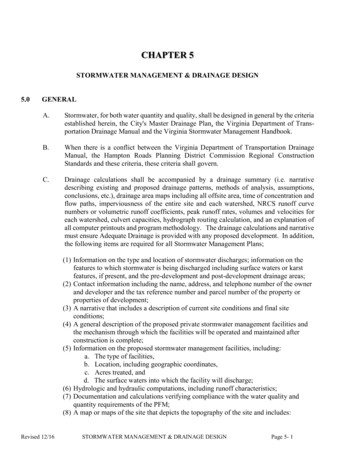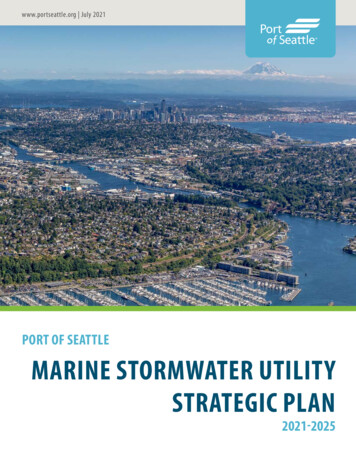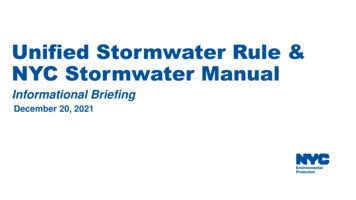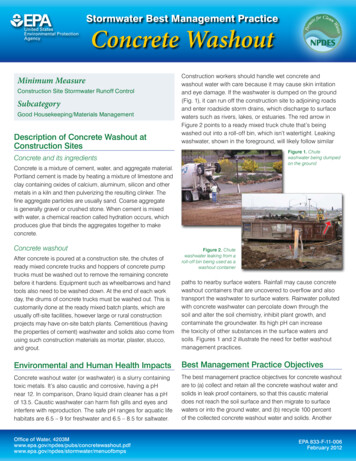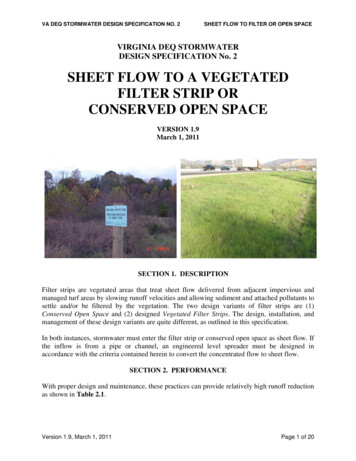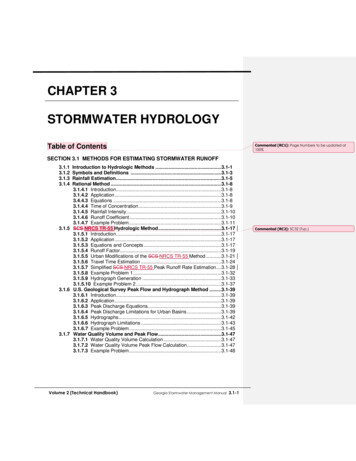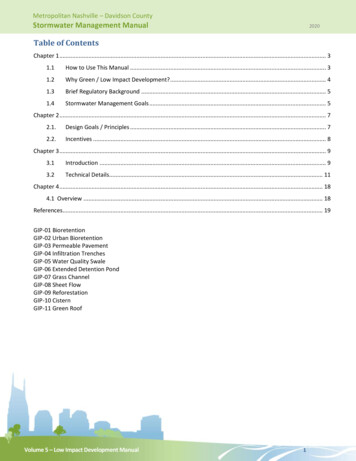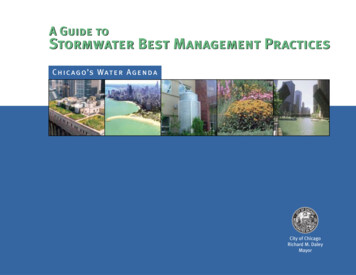
Transcription
A Guide toStormwater Best Management PracticesC h i c ag o’s Wat e r A g e n daCity of ChicagoRichard M. DaleyMayor
A Message FromMayor Richard M. DaleyLike the air we breathe, water is a vital natural resource and an important part of ourquality of life. We all need to be aware of the importance of water in our daily lives and wemust protect it now, so that it never becomes an endangered resource. We must take thisinto account when designing residential, commercial and industrial developments.As part of Chicago’s Water Agenda, the City is demonstrating and promoting innovativealternatives to managing stormwater, including roof gardens, permeable paving surfacesand rain gardens. These are examples of attractive and water-friendly alternatives toconventional stormwater management practices.The use of Best Management Practices for stormwater can be a cost-effective means toprotect our water resources. The City of Chicago is using these Best Management Practicesto address issues of water quality and water quantity in a way that is easier on our sharedwater resource, our pocketbook, and our quality of life.This booklet highlights eight practices as a guide to evaluating options in managingstormwater. I encourage you to consider these practices when preparing for stormwater atyour home and place of business.Remember, because of our location at the edge of Lake Michigan, we have a specialresponsibility to protect our water resources. Stormwater management is one importantpart of a comprehensive series of action steps to conserve, protect and manage our waterresources for future generations.Richard M. Daley, MayorCity of Chicago
TA B L EOFCONTENTSINTRODUCTION . . . . . . . . . . . . . . . . . . . . . . . . . . . . . . . . . . . . . . . . . 2BEST MANAGEMENT PRACTICES (BMPS)Green Roofs . . . . . . . . . . . . . . . . . . . . . . . . . . . . . . . . . . . . 6Downspouts, Rain Barrels and Cisterns . . . . . . . . . . . . . . 8Permeable Paving . . . . . . . . . . . . . . . . . . . . . . . . . . . . . . . 10Natural Landscaping . . . . . . . . . . . . . . . . . . . . . . . . . . . . . 12Filter Strips . . . . . . . . . . . . . . . . . . . . . . . . . . . . . . . . . . . . 14Bioinfiltration: Rain Gardens . . . . . . . . . . . . . . . . . . . . . . 16Drainage Swales . . . . . . . . . . . . . . . . . . . . . . . . . . . . . . . . 18Naturalized Detention Basins . . . . . . . . . . . . . . . . . . . . . 20SUMMARYANDA P P L I C AT I O N SResidential Site . . . . . . . . . . . . . . . . . . . . . . . . . . . . . . . . 23Commerical/Industrial Site . . . . . . . . . . . . . . . . . . . . . . . 24INDEX OF RESOURCES . . . . . . . . . . . . . . . . . . . . . . . . . . . . . . . . . . . 25
INTRODUCTION“Chicago’s world-class status is owed largely to its position at the confluence of the Chicago River and Lake Michigan. These waterwayssignified transportation and trade to Chicago settlers and continue to attract millions of visitors to our city every year.INTRODUCTIONBeyond the Lake Michigan shoreline, our water resources extend beyond, and beneath, the City. They are the Chicago River, Lake Calumet,the Calumet River, thousands of acres of wetlands, creeks, streams, and lagoons, as well as canals and channels. Equally important are thethousands of miles of pipes, man-made tributaries, that have – for over a hundred years – delivered drinking water and helped us managestormwater.2These resources are critical to our public health, safety, economy and quality of life. They provide recreational opportunities like boating,fishing and swimming. Our waterways provide natural experiences in an urban setting. We are fortunate to live near some of the cleanestdrinking water in the world.” City of Chicago’s Water Agenda 2003, released by Mayor Richard M. Daley, April 8, 2003.This guide is intended to be a first step in addressing the challenge of better managing our water. Specifically, it provides guidance todevelopers, residents, and other community members on methods to protect our water resources by reducing the amount of stormwaterdraining into the sewer system and local waterways.Stormwater runoff from developed land in the City of Chicago causes a number of problems when it is not effectively managed. Excessstormwater can cause basement and street flooding, as well as overflows to the Chicago River and backflows to Lake Michigan that result inbeach closings. Where stormwater is discharged directly to waterways, such as the Chicago River, it degrades water quality. Since mostrunoff in the City is captured by combined sewers and routed to treatment plants, increased runoff raises the cost of wastewaterpumping and treatment by the Metropolitan Water Reclamation District.When does stormwater become a problem rather than a resource? First, we need to understand how stormwater moves through the City.Increased stormwater runoff is caused principally by impervious (impenetrable) surfaces – conventional rooftops, parking lots, roads, alleys,playgrounds, and sidewalks. Developers typically seek to rapidly move stormwater away from the development site via gutters, sewers andartificial channels. While this approach is intended to prevent local flooding and undesired water ponding, it may actually cause flooding. Italso short-circuits the opportunity for water to naturally soak into the ground – to water plants and recharge groundwater resources.
Fortunately, there are both proven and evolving alternatives to conventional drainage techniques and site designs that can substantiallyreduce surface runoff quantities and resultant pollutant loadings. These alternative development techniques, commonly called BestManagement Practices or BMPs, are aimed at soaking up every drop of rainwater close to where it falls. Common goals of Best ManagementPractices are to: reduce the amount of impervious surface areas to reduce stormwater runoff; and utilize the landscape and soils to naturally move, store and filter stormwater runoff before it leaves the development site.In some cases, concerns have been raised about maintenance, publicsafety, and aesthetics. Developers sometimes perceive environmentallyconscious designs as being more expensive and less marketable to buyers.They are also concerned about possible time delays in getting approvals fornon-conventional project designs. These types of concerns generally can beaddressed through better information, improved design guidance, andpublic education.A number of national organizations, such as the Urban Land Institute, NationalAssociation of Home Builders, and American Society of Civil Engineers haveclearly documented the rationale for and advantages of alternative site designapproaches incorporating Best Management Practices.INTRODUCTIONWhile it is true that some of the Best Management Practices recommended in this guide will require a rethinking of current stormwater designphilosophy, there are many opportunities to incorporate the recommended approaches on most development sites, including design layoutsfor individual buildings and larger developments. Many of these practices can reduce both construction costs and long-term maintenancecosts. Every development can benefit by applying Best Management Practices. In assessing which practices are best for a site, it’s necessaryto consider site features, size, location, and usage.Natural drainage practices, in combination with design approaches thatminimize impervious areas, can significantly reduce development costs. Thesesavings can improve construction affordability and maintain acceptablestandards of public health, safety and welfare.Drainage swales are one of the Best Management Practices thatcan effectively move water from parking and other areas.3
S T O R M W AT E R R U N O F F I M P A C T SStormwater runoff causes two key impacts: (1) excess water volume, or quantity, and (2) degraded water quality.Runoff quantity is affected by the addition of impervious surfaces and by soil compaction caused by grading activities. These changesdramatically increase the rate and volume of stormwater runoff, and reduce the opportunity for natural absorption and groundwaterrecharge. Further, site grading and drainage devices, such as storm sewers and lined or compacted channels, eliminate natural depressionsand convey runoff water downstream at a much faster rate. This causes a number of negative consequences:INTRODUCTIONIncreased flooding: Flood flow rates can increase by 100 to 200 percent or more without effective stormwater controls. In Chicago, excessstormwater increases the frequency and severity of basement and street flooding.Combined Sewer Overflows: When there is too much stormwater entering Chicago’s combined wastewater and stormwater sewers, thesewers overflow, and untreated waste and stormwater is released into the Chicago River.Backflows to Lake Michigan: Due to large volumes of water in sewers, in severe storm conditions excessive runoff requires the opening ofstructures that allow flow of contaminated waters to Lake Michigan. Elevated pathogen levels associated with backflows result in beachclosings, which have been shown to be on the rise in recent years. Backflows also contribute various pollutants to Lake Michigan thatdegrade near-shore water quality.Urban stormwater is contaminated with a number of pollutants includingsediment, heavy metals, petroleum-based hydrocarbons, nutrients,pesticides, chlorides, bacteria and oxygen-demanding organic matter.Stormwater runoff quality is a particular concern for developments thatdrain directly to the river system. Impacts include sediment contamination,toxicity to aquatic life, bacterial contamination, and excessive phosphorusand other nutrients in the water body (causing unwanted algae growth inrivers and lakes).Much can be done to address these issues and utilize stormwater as theresource that it is.Chicago’s Green Bungalows program encourages the use of greenroofs. Green roofs are one of the many BMPs that will berecommended in this guide to handle stormwater runoff.4
OVERVIEWThis guide presents several practical site design and drainage Best Management Practices for developments in the City of Chicago. Most ofthe Best Management Practices apply to residential, commercial and industrial developments. All of them are effective in reducing thequantity and improving the quality of stormwater runoff. The guide provides the following information for each of the recommended BestManagement Practice approaches:a description of the Best Management Practice, its effectiveness and other benefits;applicability to different urban development and redevelopment settings;maintenance considerations;cost considerations compared to conventional designs; andlocal examples.Although this guide is designed to provide enough information to begin a conversation on the use of Best Management Practices to managestormwater runoff, it is not the intent of this guide to provide in-depth "how to" guidance. There are a number of detailed manuals thatprovide technical guidance for designing and installing alternative stormwater and site design techniques. These references are included inthe back of this guide.It is recommended that Best Management Practices becombined in sequence to maximize their benefits.This design philosophy is known around the countryby terms such as the runoff reduction hierarchyor stormwater treatment train. Examples of integratedapplications for urban residential and commercial/institutional sites are provided at the end of the guide.INTRODUCTION Natural landscaping is another BMP that can help manage stormwater and beaesthetically pleasing at the same time. Shown here is the Peirce School ofInternational Studies in Chicago.5
BEST MANAGEMENT PRACTICESGREEN ROOFSGREEN ROOFS“Green” roofs are layers of living vegetation installed on top of buildings, from smallgarages to large industrial structures. They help manage stormwater and contribute toimproved water quality by retaining and filtering rainwater through the plant’s soil androot uptake zone. The water that does leave the roof is slowed, kept cooler and isfiltered to be cleaner. Green roofs can also further insulate the building, reducingcooling and heating costs.Key considerations for implementing green roofs include the structural andload-bearing capacity of the building, plant selection, waterproofing, and drainage orwater storage systems. The quantity of rainfall retained or detained by a green roof canvary. For small rainfall events little or no runoff will occur and the majority of theprecipitation will return to the atmosphere through evaporation and transpiration. It hasbeen estimated that green roofs, in comparison to conventional roofs, can reducecadmium, copper and lead in runoff by over 95 percent and zinc by 16 percent; nitrogenlevels also can be diminished.In addition to the stormwater benefits, green roofs extend the life of roofs two to threetimes. They can help preserve habitat and biodiversity in an otherwise sterile urbanenvironment. Green roofs can also improve air quality by helping to reduce the “urban heat island” effect. Finally, they can provide gardenareas and attractive views for other buildings.The two most effective types of green roofs are: Extensive systems, with 2 to 4 inches of soil, 12 to 40 pounds per square foot of roof area, short plants with shallow root systems,and easy maintenance. Extensive systems absorb stormwater and provide insulation. Intensive systems are similar to gardens on the ground. They have a minimum of 6 to 12 inches of soil, 80 to 150 pounds per squarefoot, host deeper-rooted plants, including shrubs and trees, and require more maintenance. This type of roof provides morestormwater benefits, including insulation, water filtration, storage and increased habitat opportunities.ApplicabilityIn both new building designs and rehab opportunities, the load-bearing capacity of the roof maydictate the most appropriate type of system. Green roofs are appropriate in most of theproperties in the City including residential, commercial, industrialand institutional properties.6
Maintenance ConsiderationsOnce a green roof is well established, maintenance requirements are usually minimal. Maintenance requirements may include inspection ofthe roof membrane and drainage flow paths. Some watering may be required during the first few years when root systems are gettingestablished. Depending on the dimensions of the planting, some weed removal may be necessary as well. Of course, the more complex thegarden, the more it needs to be maintained like a typical garden.Cost ConsiderationsLocal ExamplesAs part of the City’s Urban Heat Island Initiative, a20,300 square foot semi-extensive green roof wasinstalled in 2000 on top of Chicago’s City Hall. Therooftop garden was the first of its kind in Chicago(right). Many sites throughout Chicago haveworked to establish rooftop gardens, especiallycontainer collections. The Chicago Center for GreenTechnology has established an extensive greenroof and has also installed nine test plots tomonitor water quality and quantity aspects ofdifferent types of green roofs. The Garfield ParkConservatory is conducting a study demonstratinga variety of plants, roof slopes, depths and types ofmedia used in green roof systems.GREEN ROOFSIn the United States, green roof costs - including everything from waterproofing to plants - tend to range from 18 to 25 per square foot,depending on how intensive the system is. The initial capital and ongoing maintenance costs of a green roof are offset by some long-termcost savings - most notably roof maintenance and replacement and utility costs. A vegetated roof, on average, can be expected to prolongthe life of a conventional roof by at least 20 years because the vegetation prevents the roof from being exposed to ultraviolet radiation andcold winds.Green roof on top of Chicago’s City Hall.7
DOWNSPOUTS, RAIN BARRELS AND CISTERNSDOWNSPOUTS, RAIN BARRELS8ANDCISTERNSTraditionally, roof runoff in Chicago has been routed viadownspouts directly into the sewer system. However, the City ofChicago encourages the careful disconnection of downspouts sothat roof runoff can flow directly into vegetated areas. There areseveral options for doing this: Runoff can be sheeted across the lawn(see “filter strip” discussion). Runoff can be routed via a surface swale into a raingarden or onsite detention or retention facility(see separate discussions of these approaches). Runoff can be temporarily stored in rain barrelsor cisterns.Rain barrels can effectively capture and store the runoff fromsmall to moderate storms. The stored water then can be used toirrigate lawns and landscaped areas in between storm events.Why take from the lake what you can get from the sky? Lawn and landscapeirrigation can be provided by rain barrels.The effectiveness of rain barrels (or cisterns) is a function of their storage volume in comparison to the size of the roof. In a simpleresidential example, a 1,200 square foot roof could utilize 55-gallon barrels to store runoff from downspouts at the four corners of the house.The resultant storage is equivalent to about 0.3 inches of runoff. While this volume will not substantially reduce flooding from large storms,it can considerably reduce direct runoff from smaller storms and divert water from the combined sewer system. The actual effectiveness ofthis approach will depend on the regular draining of rain barrels (such as for irrigation) between storm events. In that respect, rain barrelsare most effective when used during the growing season.ApplicabilityEffective downspout disconnection requires that there be adequate landscaping or vegetation available to accept the water. Rainbarrels are appropriate where vegetation is limited, provided that the collected water can overflow to open green space areas. Diversionand/or storage of roof runoff with rain barrels or cisterns is applicable to most residential, commercial and institutional properties in the City.
Maintenance ConsiderationsCost ConsiderationsTypical costs for a ready-made rain barrel range from 20 to 150. Homeowners can reduce costs by making their own.Local ExamplesMuch of the rain that falls on Chicago Center for Green Technology’s roof flowsinto four 3,000-gallon cisterns and is later used to water the landscape (right).Some of Chicago’s Green Bungalows utilize rain barrels in yard and gardenareas (below).DOWNSPOUTS, RAIN BARRELS AND CISTERNSOccasional cleaning may be necessary to remove debris, such as leaves, coming off the rooftop. A mesh filter can be inserted at the top of arain barrel. The barrel must be sealed during the warm months of the year to avoid mosquito breeding. To avoid freezing, the rain barrelshould be drained prior to winter.9
PERMEABLE PAVINGPERME ABLE PAVINGPermeable paving refers to paving materials – typically concrete, stone or plastic –that promote absorption of rain and snowmelt. The discussion that follows focusesprimarily on one form of permeable pavement – paving blocks and grids, as they arethe most common and available type of permeable paving. These modular systemscontain openings that are filled with sand and/or soil. Some can support grass orother suitable vegetation, providing a green appearance. A portion of rainfall istrapped in the block's depressions and infiltrates into the underlying soil.Permeable paving is effective in reducing the quantity of surface runoff, particularlyfor small to moderate-sized storms. It also reduces the runoff pollutants associatedwith these events. Permeable paving in Chicago will be most effective in areascloser to Lake Michigan that are underlain with sandy, permeable soils. Effectivenesscan be improved by designs that: maximize the openings in the paving material and provide an effective permeable sub-layer (e.g., at least 12 inches).Paving Blocks and GridsPermeable paving may have aesthetic and marketing advantages over conventional paving, depending on the materials selected. Vegetatedpavers, in particular, could substantially improve the aesthetic appeal of paved areas. Vegetated pavers also can be effective in reducing the“urban heat island” effect.An alternative form of permeable paving is porous pavement that relies on larger particles in the aggregate to rapidly infiltrate precipitation into anunderlying stone "reservoir." While not discussed at length in this guide, porous pavement may be a suitable option for certain low-impactapplications. Porous pavement may be prone to clogging, be adversely affected by the freeze/thaw cycle and can have higher maintenance requirementsthan permeable paving. However, some recent reports - mostly from warmer climates - conclude that porous pavement may be a reliable, cost-effectivealternative. One key consideration when using porous pavement is to ensure that the aggregate is sufficiently durable.ApplicabilityPermeable paving is particularly appropriate for the following applications: overflow and special event parking, driveways, utility andaccess roads, emergency access lanes, fire lanes and alleys.10
Maintenance ConsiderationsVegetated paving blocks may require occasional mowing. Snow plowing may require special care due to the slightly uneven surface ofthe pavement.Cost ConsiderationsLocal ExampleGad’s Hill Center at 1919 W. Cullerton uses permeable paving for its parking lot (left). The ChicagoDepartment of Transportation used paving blocks in a demonstration project in the 48th Ward. TheChicago Center for Green Technology (right) has permeablepaving in the demonstration garden area.PERMEABLE PAVINGInstallation costs for permeable paving can be as much as two to three times greater than conventional concrete or asphalt. However, thereare indications that permeable paving requires less frequent replacement. Also, because it substantially reduces runoff quantities,permeable paving can substantially reduce related stormwater engineering and infrastructure (e.g., curbs, gutters and storm sewer) costs.These savings can at least partially offset the higher installation costs.11
N AT U R A L L A N D S C A P I N GNATURAL L ANDSC API NGNatural landscaping refers to the use of native vegetation – particularly prairie, wetlandand woodland species – on a development or redevelopment site. Native vegetation is a low-costalternative to traditional landscaping that utilizes turf grass and ornamental plantings.12A site that is naturally landscaped will produce substantially less stormwater runoff than aconventional landscape. Native vegetation enhances both absorption of rainfall and evaporation of soilmoisture due to extensive root systems that extend down 3 to 10 feet or more. In contrast, the root zoneof turf grass typically extends only about 3 to 4 inches. The benefits of natural landscaping are enhancedif runoff from impervious surfaces is routed across native vegetation buffer strips. A local residential siteassessment indicated that annual storm runoff volumes from a residential development could bereduced by as much as 65 percent by utilizing swales and filter strips with native wet prairie and prairievegetation. Similarly, natural landscaping reduces pollutants associated with urban runoff. In theresidential site assessment, it was estimated that removal rates for suspended solids and heavy metals(such as cadmium and lead) could be as high as 80 percent and removal rates for nutrients (such asphosphorus and nitrogen) could be as high as 70 percent for a residential development utilizingnatural drainage and native landscaped filter strips.In addition to reducing stormwater runoff, natural landscaping provides a host of other benefits.Deep-rooted native plants effectively stabilize soils and prevent erosion along streambanks anddetention basin edges. The reduced maintenance needs of natural landscaping not only save money,but also reduce air, water and noise pollution. Natural landscaping also provideshabitat for native and migrating birds, butterflies, and insects. Natural landscapes,especially trees, also moderate temperature extremes (such as the “urban heat island” effect),resulting in reduced heating and air conditioning costs. Finally, natural landscaping provides fourseasons of color and textures not commonly found in conventional landscapes and requires lessmaintenance over time.ApplicabilityNatural landscaping is feasible on nearly all sites as an alternative to conventional landscaping. Itshould be tailored to individual site characteristics, factoring in topography, soils, drainage patternsand sun exposure. On some sites natural landscaping can be installed or preserved in an informal setting; on others, native plants can be used in more formal settings in place of imported species.Suggested site applications include: river or wetland edges, detention basin and drainage features,parks, green roofs, residential areas and gardens, commercial, industrial and institutionaldevelopments.Root length of conventional turfgrass (left) as compared tonative plant roots (right).
Maintenance ConsiderationsCost ConsiderationsCosts will vary from site to site depending on site size, plant selection and other factors. In general, it is expected that installation costs willbe similar for both conventional turf and natural landscapes (roughly 2,000 - 4,000 per acre). Conventional landscaping costs will behigher if sod and irrigation systems are installed. In the long run, maintenance costs for natural landscapes will be much lower thanconventional landscapes – typically half or as little as one-fifth the cost of conventional landscapes.Local ExamplesThe Peggy Notebaert Nature Museum of the Chicago Academy of Sciences has installed a natural landscapeon its campus (center and right) that links to the naturalized shoreline of the North Pond in Lincoln Park.NATURAL L ANDSC API NGNatural landscaping requires much less maintenance – less irrigation, mowing, fertilizer and pesticides – than conventional landscaping.Natural landscape maintenance typically involves annual mowing or controlled burning. Burning may not be possible on small lots but it isone of the best methods of maintaining natural landscaping. Some initial watering and spot spraying to control invasive weeds also may beneeded, but this need diminishes rapidly once the natural landscape is well established (generally within 3-4 years).13
F I LT E R S T R I P SF I LT E R S T R I P SFilter strips are vegetated areas that are designed to receive runoff from adjacentimpervious surfaces. They work by slowing runoff speed, trapping sediment and otherpollutants, and providing some absorption. While frequently planted with turf grass, filterstrips may also employ native vegetation, which is more effective in removing nutrients.Filter strips can reduce both the rate and volume of stormwater runoff on a site. This isachieved principally by absorbing runoff into the soil.Well maintained filter strips can be very effective in reducing runoff volumes, particularlywhen the impervious drainage area is not overly large (such as more than 4 to 5 times thefilter strip area.) Filter strips are most effective in reducing surface runoff volumes – by upto 40 percent – for small storm events (storms up to the magnitude that may occur, onaverage, once every year or every other year).Filter strips remove suspended solids through settling and filtration. Dissolved pollutants are removed and/or transformed as runoffinfiltrates into the ground. Effectiveness is improved when there is dense vegetation. The use of native vegetation can provide additionalbenefits for pollutant filtering and runoff absorption. The plants selected should be able to withstand flowing water, and both wet and dryperiods. A properly designed and maintained filter strip may remove up to 70 percent to 95 percent of suspended solids and metals (such ascadmium and lead), 25 percent to 65 percent of nutrients (such as phosphorus and nitrogen), and biochemical oxygen demand (the degreeof organic pollution in water leading to the depletion of oxygen). However, soluble inorganic compounds (most notably road salt) aregenerally not well removed in the soil and will eventually migrate downstream or into deep groundwater.Filter strips function best when applied on gentle slopes, thereby keeping runoff speed low and maximizing opportunities for absorption ofrunoff and filtering of pollutants. The longer the water moves through a treatment such as this, the more it can be absorbed and the cleanerit will get. Filter strips must disperse the flow as evenly as possible to avoid straight, deep channels, which can reduce effectiveness. Wherefeasible, a filter strip width of at least 20 feet is recommended, although narrower widths can be effective on flat slopes.ApplicabilityRoof runoff and parking lot runoff can be distributed over the width of lawn areas to promote absorption and filtering. Filter strips arestrongly recommended in buffer zones between developed areas and sensitive aquatic environments. They are particularly appropriate asbuffers for land uses that generate high pollutant loads, such as roadways and parking lots, and are useful in controlling erosion andsediment wash off during construction. Filter strips are probably most appropriate on developments where there are significantexpanses of pervious areas (green spaces) adjacent to impervious surfaces (such as parking lots). Specifically, they may beused in the following applications: residential (roof runoff ), commercial (roof and parking lot runoff ) andvegetated buffers (adjacent to stream or wetland areas).14
Maintenance ConsiderationsTypically, maintenance involves normal activities such as mowing, trimming, removal of invasive species and additional planting if necessary.Cost ConsiderationsLocal ExamplesThe Chicago Center for Green Technology (right)uses filter strips to
The use of Best Management Practices for stormwater can be a cost-effective means to protect our water resources. The City of Chicago is using these Best Management Practices . cadmium, copper and lead in runoff by over 95 percent and zinc by 16 percent; nitrogen levels also can be diminished. In addition to the stormwater benefits, green .
